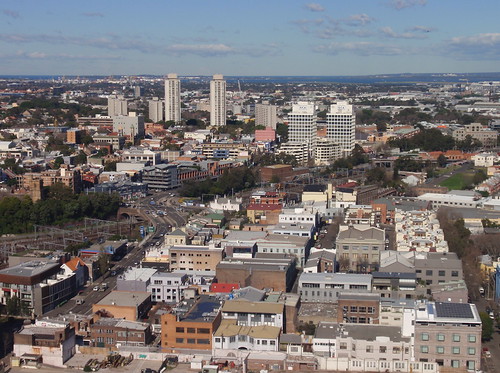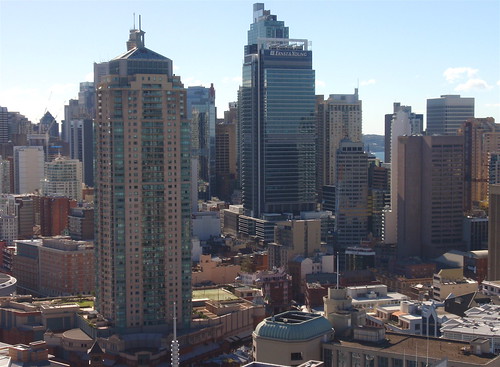
It's a view of the southern suburbs of Sydney, across the main southern and western railway line and the airport to Botany Bay. I can clearly see the building in which I live, and this gives me a strange pleasure - I think because it makes me feel that my life is deeply rooted in this part of Sydney.
This is the view from my colleagues' window next door to me:

Chinatown is in the foreground; then the tall buildings of central Sydney and a glimpse of the Harbour in the distance.
I've written before of how much I like living in Sydney. Having these views of my sparkling city so constantly and immediately available is a great gift.
On Monday, the weekday I don't work, the dotee, her mother and I went to Kurnell to visit Botany Bay National Park. I foolishly forgot to take my camera. It's such a strange area, though a great deal of work has been done recently to make it more attractive and pleasant for visitors and to interpret its rather ambiguous role in Sydney's development and the history of modern Australia.
As all Australian children learn in primary school, it's the site where Captain (then Lieutenant) James Cook and the crew of his ship 'Endeavour' first stepped onto Australian soil (or rock) in 1770. For Australians of my generation, we learned that this signaled 'the birth of the Australian nation'. I guess there is a sense in which this is true. It was on the basis of the reports from this trip - particularly the accounts of naturalist Joseph Banks - that British settlement in the Sydney area was later undertaken. And, while there was sophisticated Indigenous habitation of Australia prior to European settlement, the various Aboriginal groups would not narrowly be defined as a 'nation'.
The park today portrays the area as a meeting point, and emphasises both the role the Kurnell Peninsula had and has for Aboriginal people, as well as its part in the formation of modern Australia. We were particularly delighted and surprised by a soundscape installed around some of the paths, where the voices of modern day children learning Aboriginal languages, playing, and calling to one another - even 'coo-ee'- are activated as you pass along the path. The dotee was intrigued, puzzled and entertained.
But the modern setting of this meeting point is bizarre. How I wish I'd had my camera. Close to the memorial commemorating Cook's landing is a long quay for the pipeline from the nearby oil refinery that enables ships to be loaded with oil. Clearly visible across Botany Bay are the docks and cranes of Port Botany, now Sydney's main sea port. And the jet planes boom constantly across the Bay to land at the airport. It's a highly industrialised modern landscape, situated on a beautiful bay. Close to the park is Cape Solander, where you can view the ancient grandeur of the ocean cliffs south of Botany Bay and where on Monday various groups of people were watching for whales making their timeless passage along the Australian east coast.
Much as I love cities, and Sydney in particular, Kurnell is unsettling. A disturbing mixture of the present and the past.
2 comments:
WOW
great view
All the windows in our buildings are dirty so the views are quite foggy
This is a great reflection on Sydney and our kind of odd history. I know what you mean about places like Kurnell. It still amazes me to see old sewerage or drainwater pipes at beaches like Manly and Coogee. Of course, it makes PERFECT sense to send our waste into the ocean right near the beaches! Oh dear.
Post a Comment